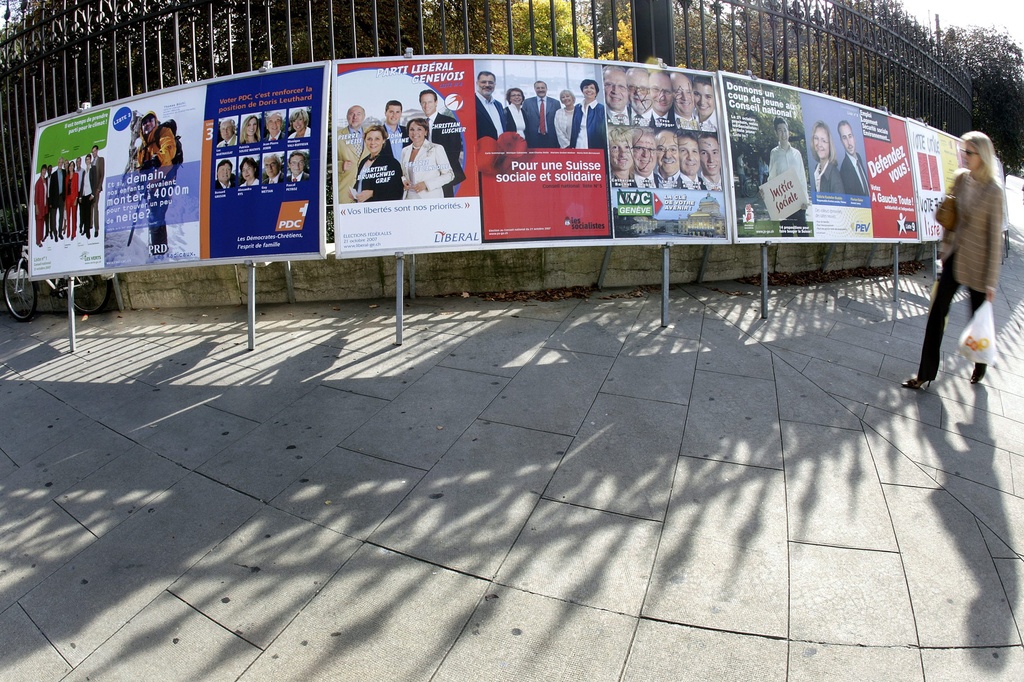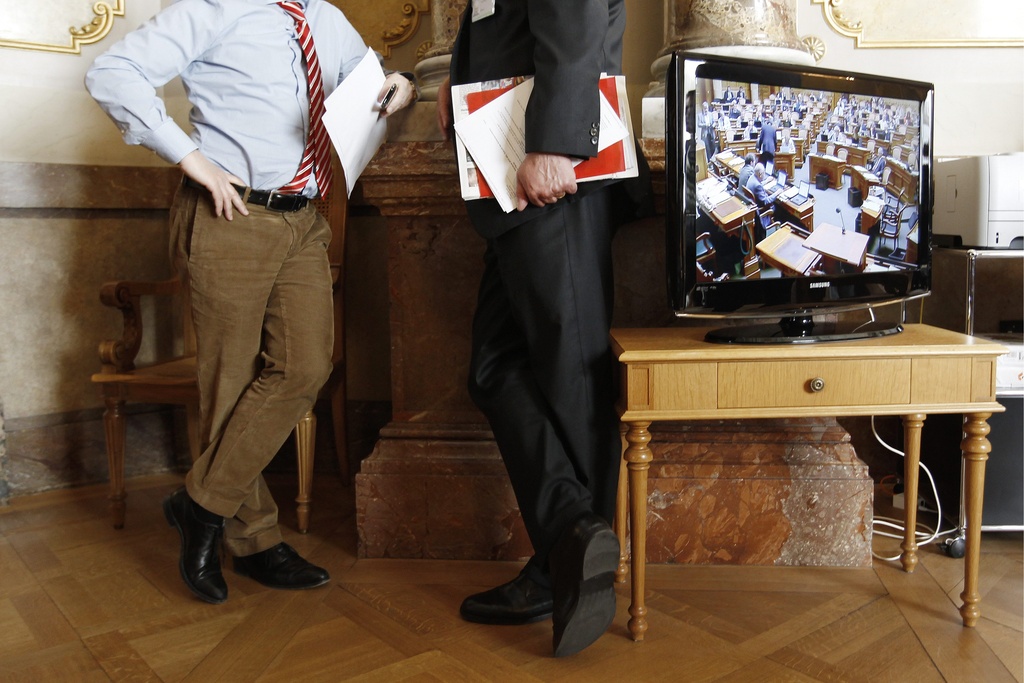Confrontation puts consensus at risk

Experts have warned Switzerland could become ungovernable if the polarisation of the political system continues in October’s parliamentary elections.
Shifting from moderate pluralism over the past two decades Switzerland has now the most adversarial party political system in Europe, according to a comparative study of 30 countries. (See box: Resemblance and Differences)
“Switzerland basks in the illusion of consensus, while in reality we find ourselves in a conflict-laden political system,” says Pascal Sciarini, professor of political science at Geneva University. Speaking on the sidelines of a symposium on Swiss parties in Lausanne, Sciarini called for a “collective awakening” to the new reality.
The transformation of the Swiss political scene began gently in the 1970s and then really got underway in the early 1990s. In the space of about 20 years, Switzerland has gone from a culture of consensus to being the most politically polarised country in Europe.
“When you compare the programmes of the political parties in the different countries, you find that the most extreme differences are in Switzerland,” says Andreas Ladner, professor at the Graduate School of Public Aministration (Idheap).
Two factors have led to this situation, and they are reinforcing one another, according to his colleague Ioannis Papadopoulos of Lausanne University.
“In the first place, there is a widening of the political divide between Left and Right, notably on matters of economic, fiscal and social policy,” Papadopoulos says.
Then there is also a political divide between advocates and opponents of opening up Switzerland to the outside world, he adds.
Old parties in decline
The specialists say further polarisation is likely in the forthcoming parliamentary elections. Results of recent cantonal ballots as well as recent opinion polls indicate that the rightwing Swiss People’s Party will possibly exceed the 30 per cent mark.
The centre-left Social Democrats and Greens are expected to remain stable, while the centre-right should come out even more fragmented than before.
The vote going to the centre-right should remain steady at around 30 per cent, but there will be two more parties sharing it than were up for election in 2007. The Conservative Democratic Party, which was launched in 2008 after a split in the People’s Party, and the Liberal Greens, which started in just two cantons four years ago.
“We can just about take it for granted that the two major historic parties, the Radicals and the Christian Democrats, will continue to decline in the October election,” Sciarini says.
Cutting deals
While the political landscape has changed radically, the institutions themselves have not. This is having a significant effect on Swiss political life as it is based on negotiation aimed at reaching a consensus solution.
However, with two poles – the People’s Party on the right and the Social Democrats on the left – both with a high profile, and a fragmented centre, the outcome of the negotiations is always uncertain, because it depends on reaching a compromise with the other parties, Ladner says.
Therefore parliamentary decisions now turn on compromises that are more and more informal.
“The coalitions are more changeable and more unpredictable all the time. Today there is major instability. So far, the damage has been limited, but I doubt that we can go on like this indefinitely,” Scarini warns.
Schizophrenic
He notes a kind of schizophrenia between the results of elections and decision-making in the political system.
“On the one hand there is one party – the People’s Party – which wins elections but doesn’t get to make policy, and on the other hand there are parties – the Radicals and the Christian Democrats – which do get to make policy but keep losing elections,” the political scientist says.
These two parties make up the majority by means of an impromptu coalition, winning up to nine out of ten votes in parliament. However, if they continue to lose electoral support, “they will soon no longer be strong enough to dictate policy”, Sciarini explains.
Another temporary alliance in parliament sees the People’s Party and the Social Democrats cooperating to form a united opposition.
“It may be for diametrically opposed motives but it manages to torpedo important pieces of legislation,” Sciarini says.
Instances of this “alliance of opposites” occur quite rarely. Since 1996 they have swayed only 1.5 per cent of the decisions of parliament, according to Oscar Mazzoleni of Lausanne University.
But the phenomenon of the united fronts – destructive in nature – preoccupies the political scientists.
Governability at risk
While the danger that the workings of parliament may grind to a halt is just around the corner, the problems caused by polarisation are already obvious in the government.
“The two parties which have profited by the polarisation – and which have created it, namely the People’s Party and the Social Democrats – are still together in government, but they are no longer capable of governing together,” says Sciarini.
The same is true for nationwide votes on a particular issue. “There is hardly one in which the government is not challenged by at least one of the governing parties, either the People’s Party or the Social Democrats.”
The last, but not the least worrying consequence of this growing polarisation is that parties are permanently “on the campaign trail”, according to Sciarini.
“Today all parties launch initiatives, even those who never did so before. They seem obsessed with their own electoral scores and care much less about political decision-making to find solutions to the country’s problems.”
A comparison of political parties in various countries showed that liberal parties are the most heterogeneous.
The Green Parties are the most homogenous, according to the Europrofiler research project.
Switzerland’s Social Democrats are further left than their counterparts in other European countries.
The People’s Party distinguishes itself from the rightwing populist parties in other European countries because of its attachment to liberalisation of the economy and a restrictive financial policy.
The survey on similarities of political parties was carried out by the European University institute in Florence and published in 2010.
The Swiss Radical Party is considered less liberal, both in economic policy, and in terms of the values of modern society, than its sister parties in other European countries.
The Christian Democratic Party in Switzerland is in the centre, and more or less in line with the positions of other conservative parties in Europe.
Twelve political parties have seats in the Swiss parliament and five of them are represented in the government.
The Swiss People’s Party has a total of 66 seats in the 246-strong parliament. The Social Democrats hold 49 seats, while the Radicals and Christian Democrats have 47 and 44 representatives respectively in the two parliamentary chambers. The Greens have 22 seats.
The political scientists quoted in this article attended an interdisciplinary symposium in June. It was organised by Lausanne University and the Democratic Club of Lausanne.
(Adapted from Italian by Terence NacNamee and Urs Geiser)

In compliance with the JTI standards
More: SWI swissinfo.ch certified by the Journalism Trust Initiative














You can find an overview of ongoing debates with our journalists here . Please join us!
If you want to start a conversation about a topic raised in this article or want to report factual errors, email us at english@swissinfo.ch.